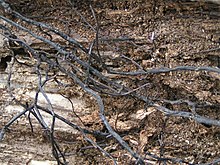Rhizomorphs
Rhizomorphs - singular : the rhizomorphs - are thickened strands of some mushrooms consisting of hyphae , which are composed of insulating outer and fine inner hyphae. The outer layer is usually significantly thickened, mostly pigmented and sclerotized by melanin . The rhizomorphs not only look similar to the roots of plants , they also serve to transport substances like these. Rhizomorphs are mainly used to develop new substrate sources. But they can also be used to transport substances to the fruiting bodies at more distant locations. Rhizomorphs are known from the honey fungus ( Armillaria species), which use them to penetrate the root system of various woody plants and - then further ascending in the trunk - enzymatically break down the wood of almost every tree species in the form of white rot . As "soil rhizomorphs", they can penetrate further and further below the surface of the earth and even extensively cause woody stands to die off.
Rhizomorphs differ in their composition from Myzelsträngen as for example when broadleaf and tear ends dry rot ( Serpula lacrymans occur). This is because these are undifferentiated.
literature
- Hans Otto Schwantes: Biology of the mushrooms. An introduction to applied mycology (= university paperbacks . Volume 1871 ). Ulmer, Stuttgart 1996, ISBN 3-8252-1871-6 , pp. 44 .
